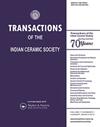A Facile Synthetic Approach for Cu(OH)2-Cu2O Heterostructure: A Stable Catalyst for Pollutant Degradation
IF 1.5
4区 材料科学
Q3 MATERIALS SCIENCE, CERAMICS
引用次数: 0
Abstract
In the present study, we report the development of morphologically different copper and Cu(OH)2-Cu2O nanostructures by a single step chemical reduction method using ascorbic acid as environmental friendly reducing agent. Morphology and crystallographic patterns of the synthesized samples were analyzed using X-ray diffraction and scanning electron microscopy. Determination of catalytic performance of both copper and Cu(OH)2-Cu2O nanostructure towards hydrogenation reduction of para nitrophenol and para nitroaniline using sodium borohydride as the reducing agent suggested that Cu(OH)2-Cu2O nanostructure is comparatively efficient in hydrogenating the nitro aromatic compounds. The improved hydrogenation capacity was suggested to be due to the formation of an in-situ composite of Cu2O-Cu during the time of reduction reaction. Analysis on the degradation capacity of developed samples for methyl orange degradation using sodium borohydride as the reducing agent indicated significantly high reduction rate for Cu(OH)2-Cu2O nanostructure with a rate constant value of 0. 819 min-1, which is higher than many of the previously reported values. GRAPHICAL ABSTRACTCu(OH)2-Cu2O异质结构的简易合成方法:一种稳定的污染物降解催化剂
本研究以抗坏血酸为环境友好还原剂,采用单步化学还原法制备了形貌不同的铜和Cu(OH)2-Cu2O纳米结构。利用x射线衍射和扫描电镜分析了合成样品的形貌和晶体结构。以硼氢化钠为还原剂,测定了铜和Cu(OH)2-Cu2O纳米结构对对硝基苯酚和对硝基苯胺加氢还原的催化性能,表明Cu(OH)2-Cu2O纳米结构对硝基芳香族化合物的加氢效率较高。加氢能力的提高是由于在还原反应过程中形成了cu20 - cu的原位复合材料。以硼氢化钠为还原剂制备的样品降解甲基橙的能力分析表明,Cu(OH)2-Cu2O纳米结构的还原率很高,速率常数为0。819分钟-1,这比以前报道的许多值都要高。图形抽象
本文章由计算机程序翻译,如有差异,请以英文原文为准。
求助全文
约1分钟内获得全文
求助全文
来源期刊

Transactions of the Indian Ceramic Society
工程技术-材料科学:硅酸盐
CiteScore
2.40
自引率
8.30%
发文量
12
审稿时长
2.3 months
期刊介绍:
Transactions of the Indian Ceramic Society is a quarterly Journal devoted to current scientific research, technology and industry-related news on glass and ceramics. The Journal covers subjects such as the chemical, mechanical, optical, electronic and spectroscopic properties of glass and ceramics, and characterization of materials belonging to this family.
The Editor invites original research papers, topical reviews, opinions and achievements, as well as industry profiles for publication. The contributions should be accompanied by abstracts, keywords and other details, as outlined in the Instructions for Authors section. News, views and other comments on activities of specific industries and organizations, and also analyses of industrial scenarios are also welcome.
 求助内容:
求助内容: 应助结果提醒方式:
应助结果提醒方式:


